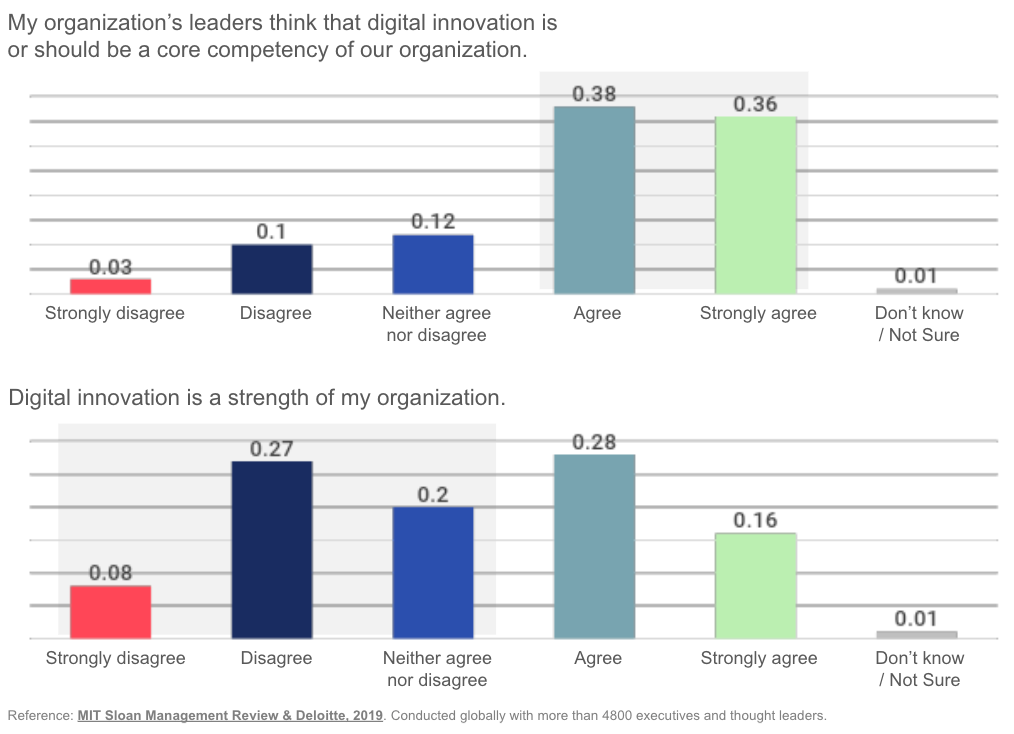
When COVID-19 first struck oh so long ago, corporate innovation programs – like many aspects of our daily lives – came to a grinding halt.
It was understandable.
After all, corporations had more pressing challenges to deal with. Things like how to adapt to an entirely WFH workforce, or how to bring more emotional intelligence into the workplace as so many of us grappled with anxiety, and depression, not to mention the loss of loved ones and friends.
Nevertheless, innovation is a cornerstone of business today. It’s as critical to a corporation’s success as marketing, human resources, or data capital.
In times of crisis, innovation is even more critical because it’s only by thinking outside the box that we can “imagineer” solutions to the unprecedented challenges we face. In fact, history suggests that enterprises who invest in innovation during a crisis outperform their peers during the recovery period.1

So really, many corporations put innovation on the backburner at the very moment that such inventiveness could have benefitted them most.
This was the climate we found ourselves in by late 2020.
Corporate innovation in crisis
As the dust of the pandemic’s first wave settled and we acclimated to our “New Normal,” innovation scouts recommenced their tentative search for promising technologies that might boost organizational resilience.
C-suite executives and thought leaders around the world expected a surge in corporate innovation as the economy (and society) recovered. But there was one problem: even though C-suite execs understood innovation was imperative to their organizations’ post-COVID recovery, many felt ill-equipped to innovate with the format of existing corporate innovation programs. As many as 55% according to McKinsey.2

Our own research found that innovation teams spend about 70% of their time scouting for promising startup partners, yet only ⅓ of those startup conversations actually lead to proof-of-concept (POC) projects.
Why?
The perceived risk of gambling on the wrong tech was too high, and the path to implementing innovative ideas was too unclear. But where others saw unnecessary risk amidst uncertain times, we saw the opportunity.
The corporate innovation relationship is built on trust
Back then, we were a team of innovation experts at Maxitech, a Bay Area corporate innovation firm. But we knew that digital transformation would be more critical than ever in a post-COVID world.
So in early 2021, we decided to conduct some first-hand research to determine:
- What exactly was holding enterprises back;
- And how startups could assuage corporate fears and form innovation partnerships.
We interviewed 50+ C-suite execs, startup founders, innovation experts, and industry thought leaders from 11 different countries. We dug deep to uncover their pain points and identify the real obstacles that stood in the way so we could tailor our platform to serve their needs.
Here’s what we found:
One of the greatest obstacles to innovation is the lack of trust. Enterprises go into sales calls skeptical of startups’ lofty promises, while the real benefits of technology get lost beneath a mountain of features and marketing lingo.
Even when startups can provide detailed case studies, 90% of enterprises said they find these materials difficult to understand due to technical jargon, or simply the lack of a universal format that makes these reports easier to compare.
Then there’s the question of objectivity. Since these case studies are typically published by the startups themselves, there’s no way to verify their accuracy – unless enterprises reach out directly to the featured customer. In our experience, enterprises requested customer references and VC insights so they could verify startups’ claims in 8 out of 10 projects. Actually getting those references proved difficult for a number of logistical reasons.
But that’s not all. Say an enterprise managed to overcome these hurdles and move into the next phase of the corporate innovation relationship: sales calls. The startup usually gets stuck in endless education meetings, parroting the same pitch as new stakeholders are brought into the project. This cycle can go on for months, costing startups precious time while innovative ideas whither on the vine and funding evaporates.
Once we had a clear picture of the challenges both enterprises and startups faced, the question became:
How can we help enterprises and startups expedite the innovation process by starting their conversations on a foundation of trust?
Introducing evidence-based innovation
The solution we envisioned was a platform where enterprises could review third-party verified evidence to find the right startup partner for the particular challenge they faced.
Think of it like an app store for enterprises.
Startups (“developers”) would submit their evidence (“apps”) in the form of case studies, research papers, proof of ROI, etc. We would then vett these startups, verify their evidence, and validate product readiness before adding them to our platform (the “app store”). Past customers could leave their testimonials (or “reviews”) while we would compile all this evidence in easy-to-understand templates, giving enterprises a clear picture of the startup’s tech.
It was with this vision in mind that we set out to create the first-ever evidence-based innovation platform. We wanted to build a streamlined innovation process that would reduce time (not to mention money) spent on scouting. We wanted to dissolve geographic, cultural, and language barriers to help innovative ideas thrive.
Now all we had to do was build the platform.
The future of innovation is evidence-based
At the start of 2021, we began building out a data collection and verification protocol. Last summer, we created an evidence template that addressed all the questions enterprises need answered in their startup scouting process. And in the final quarter of the year, through extensive first-hand research, we streamlined our matchmaking platform to filter startup technologies by use case.
Rather than starting with a keyword, an unverified news article, or hearsay about the latest Silicon Valley unicorns, innovation teams can now begin their search with a solution they know fits the problem their enterprise is trying to solve.
Next quarter will mark the soft launch of the platform we’ve spent the past year building. With 15 global enterprises and 150+ startups already using the platform, we’re well ahead of schedule.
These numbers may not seem like much compared to some of the innovation platforms out there, but we prefer quality over quantity. That’s why we’ve spent so much time carefully curating an ecosystem of enterprise-ready startups and promising innovation partners, so our users don’t have to comb through thousands of superficial profiles. And we cannot wait to introduce our community of trailblazing startups to the world.
This year, we look forward to onboarding more visionary startups and collaborating closely with enterprises to deliver the data insights they need in order to make informed innovation decisions.
While entrapeer is still in its infancy, we feel confident that entrapeer will pave the way for a new era of corporate innovation – one rooted in evidence and fueled by trust.
Sources:
[1] Am, J. B., Furstenthal, L., Jorge, F., & Roth, E. (2020). (rep.). Innovation in a crisis: Why it is more critical than ever. McKinsey & Company.
[2 ]G.C. Kane, D. Palmer, A.N. Phillips, D. Kiron, and N. Buckley. “Accelerating Digital Innovation Inside & Out.” MIT Sloan Management Review and Deloitte Insights, June 2019.

